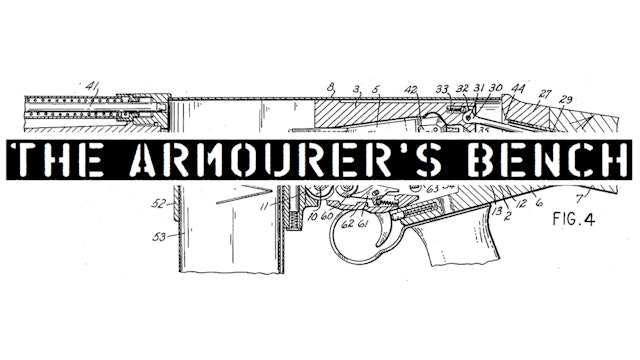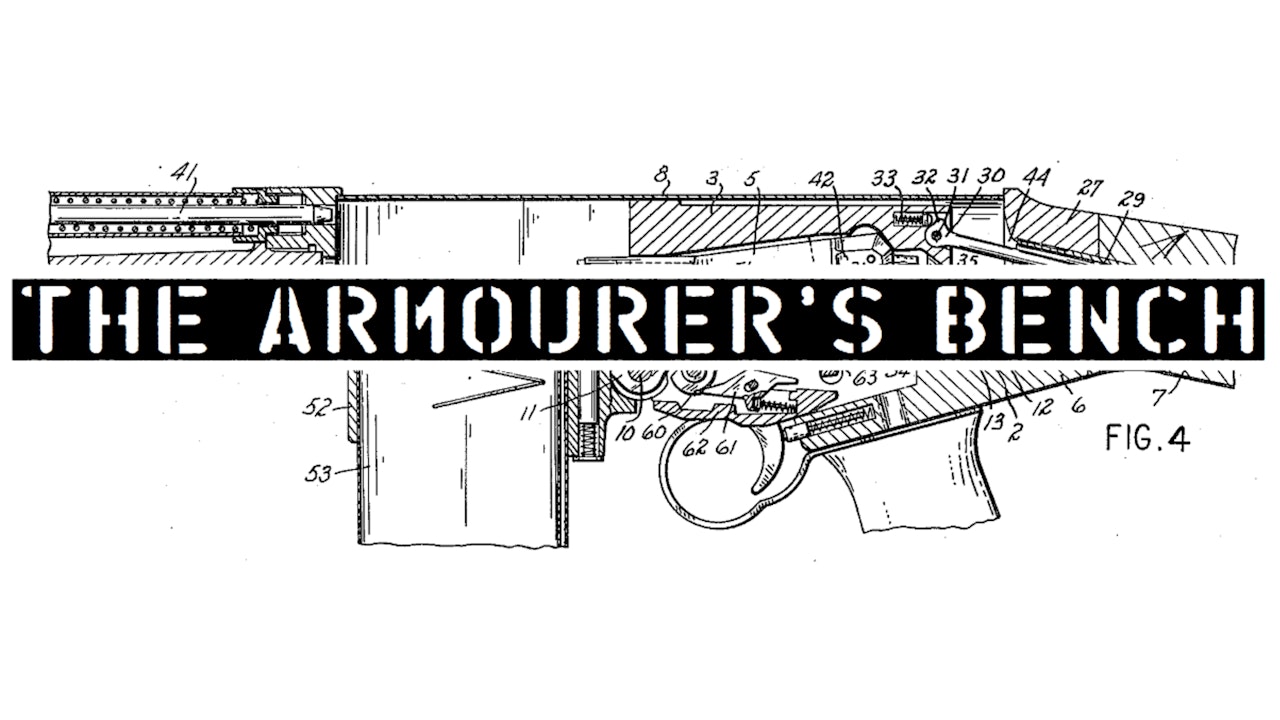The Armourer's Bench
The Armourer’s Bench is a multimedia project using both video and written articles to showcase the history of some of the world’s most interesting and important firearms. We will be bringing you detailed examinations of historic and modern small arms from around the world as well as occasionally looking at larger weapon systems. We will delve into the history, use and operation of the weapons using videos, articles and high resolution images to tell their story.
-
Vickers Gun Disassembly
The Vickers Gun is an iconic weapon, developed from the Maxim and adopted by the British in 1912. It served for over 50 years in conflicts all around the world. In this video, Richard Fisher of the Vickers Machine Gun Collection and Research Association shows us how to disassemble a Vickers. Big ...
-
Cut-Down SMLE - WW1 Tunneler's Gun
The myths surrounding the use of cut down Lee-Enfield during WW1 are fascinating. I recently had the chance to take a look at an example of a cut down SMLE, which differed slightly in that it still had its stock - which I think makes it a more practical weapon than a truly cut down rifle. In this...
-
Rifle No.4 Cutaway
We've covered a few factory and instructional cutways in the past and I personally love nothing more than a good cutaway so I always try and film any I get the chance to look at. This episode we're taking a look at a cutaway Lee-Enfield Rifle No.4. Check out the accompanying blog for this video h...
-
The Christie Amphibious Tank
Short but sweet. I found this short piece of footage while doing some archival research and it was too cool not to share. I features a demonstration of John Walter Christie's amphibious armoured vehicle - complete with firing demonstration of the vehicles 75mm gun! If you enjoy our work please co...
-
Why Wasn't the Winchester Repeating Rifle Adopted
Ever wonder why the Winchester repeating rifle wasn't adopted by 19th century military powers? As a case study in this episode Matt examines a British Army trials report from 1869 that evaluates a number of repeating rifle designs and talks about why rifles like the Winchester weren't more widely...
-
US Military Railway Guns In Action
During World War One massive railway guns were used to reach deep behind enemy lines and attack enemy infrastructure with both sides using the massive artillery pieces. In this episode Matt takes a look at some archival footage of America's massive railway guns ranging from 10 to 16 inches. Check...
-
Heckler & Koch HK33
In this episode we take a look at Heckler & Koch's first 5.56x45mm rifle, the HK33. Introduced in the late 1960s, the HK33 was Heckler & Koch's response to the emergence of the new 5.56x45mm round and FN's introduction of the FN CAL. While the HK33 wasn't adopted by West Germany it proved a popul...
-
Fort Clinch
Defending the strategically important Cumberland Sound at the very north eastern edge of Florida, work on Fort Clinch began in 1847. It remained unfinished during the Civil War and changed hands several times before it was finally completed 20 years after construction began. It was sporadically g...
-
British 6 pdr Anti-Tank Gun
The British QF 6-pounder AT Gun was introduced in 1942, joining the lighter 2pdr, the new gun was more capable of dealing with the increasing thickness of Axis armour. The 6pdr first saw action in North Africa and was used throughout the war in Europe and Asia. It also armed a series of British a...
-
WW1 2-Inch Trench Mortar
The British Army entered the First World War with no light mortars. As the stalemate of trench warfare set in and the effectiveness of German Minenwerfers became clear it was decided that trench mortars of various sizes would be needed. Nicknamed ‘plum pudding’ or ‘toffee apple’ mortars after the...
-
QF 2pdr Anti-Tank Gun
Introduced just before the beginning of WW2 the 2pdr AT Gun was more than capable of dealing with Axis tanks at the beginning of the war but as tank armour got thicker it became outgunned. Despite this the 2pdr remained in service and equipped a plethora of tanks and armoured cars including the V...
-
Webley MkIV - The 'Boer War Model'
Adopted by the British Army around the outbreak of the Second Anglo-Boer War in 1899, the Webley MkIV saw action through to the Great War. The last of the 4-inch barrel Webley's the MkIV proved to be a decent sidearm for both officers and enlisted specialists like gunners, NCOs and trumpeters. Ch...
-
Live Fire: Gerat 06(H)
Celebrating our 40th episode with a live fire video featuring a replica Gerat 06(H), the rifle that began the roller-delayed blowback dynasty which has included Spanish CETMEs and German HK's like the G3 and MP5. Developed by Mauser engineers from the gas operated Gerat 06, it produced a much lig...
-
The Benson-Poppenburg Breechloading Rifle
The 1860s saw much of Europe move to adopt breechloading rifles. Britain held extensive trials with over 20 designs tested, one of the most interesting was submitted by Johann von der Poppenburg. In this video Matt examines the engineering and history of Poppenburg's rifle and explains why it los...
-
How Many Men Does it Take to Flip a Tank?
While I was doing some research in the US National Archives' catalogue, for footage of the Ford M1918 Light Tank, I came across this snippet of film. As we saw in our earlier video on the M1918 the tank struggled to deal with some terrain. In this video we see that at one point the prototype 3-to...
-
Why is there a Sterling SMG in Call of Duty: WWII?
In this TAB Short Matt discusses how historically accurate COD:WWII's Sterling model is and whether early Sterling SMG prototypes saw action during World War Two. This is something a little different to our normal content, Matt decided to discuss it as he's just written a book about the Sterling ...
-
The Curtis Rifle - The World's First Repeating Bullpup
In this very special episode Matt examines what is probably the first repeating bullpup rifle - the Curtis. Designed by a British inventor, William Joseph Curtis, in 1866 it predates all other known bullpups. The design never left prototype stage but gain notoriety in 1895 when it was used by the...
-
British Pattern 1914 Cutaway
This short video is a bonus, filmed while we were opening one of the cases at the Cody Firearms Museum to examine another firearm (that video is coming soon) I noticed a sectioned British Pattern 14 rifle, made by Winchester for the British government during the First World War. It was too good a...
-
Heckler & Koch G41
Following NATOs standardisation of 5.56x45mm, Heckler & Koch introduced the G41 in 1981, as NATO members began looking for new rifles. HK, however, struggled to find buyers for the G41. In this episode Matt takes a look at one of HK's rarest rifles. Comparing it to its predecessor the HK33 and di...
-
Prince's Breechloading Rifle
In 1855 Frederic Prince patented an interesting breechloading action which used a forward sliding barrel that allowed it to be loaded from the breech. In this episode Matt takes a look at a beautiful example of Prince's rifle. The British Army tested the rifle in 1855 and performed well and was r...
-
Live Fire: Browning M1919A4
We're rounding out 2018 with a bang, thank you all for watching, liking, commenting, sharing subscribing and supporting TAB this year. We have many more exciting videos to bring you in the new year.
In this live fire video Matt is lucky enough to puts some rounds through the an original 1944-pr...
-
Sterling SMG 'Shotgun Sight' Prototype
The British Army tested the Sterling SMG all over the world, one of the most hostile environments it was tested in was the Malayan jungle. Troops there fitted several trials guns with a shotgun-style rib sight. It was hoped this would improve fast snap shooting during jungle patrols when contact ...
-
CETME AMELI Light Machine Gun
Vic's back! In this episode he takes a look at a very rare Spanish light machine gun, the CETME AMELI. Lucky enough to have access to an extremely rare factory cutaway model of the AMELI Vic examines how the gun works, and takes us through some of its features and discusses its history.
For Vic...
-
M1903 and Maxim Silencer
In this episode Matt takes a look at a very rare Model 1910 Maxim Silencer, even more rare as it is mounted on a M1903 Springfield. Developed by Hiram Percy Maxim, son of Hiram S. Maxim, in the early 1900s, the early Maxim suppressors were a commercial success but Maxim also sought military contr...

























